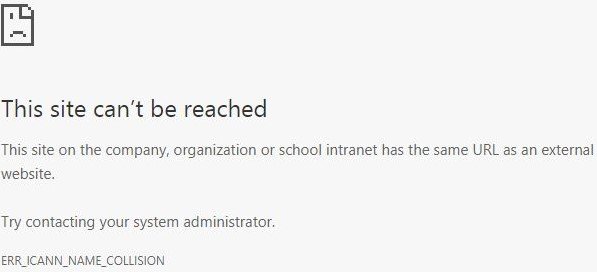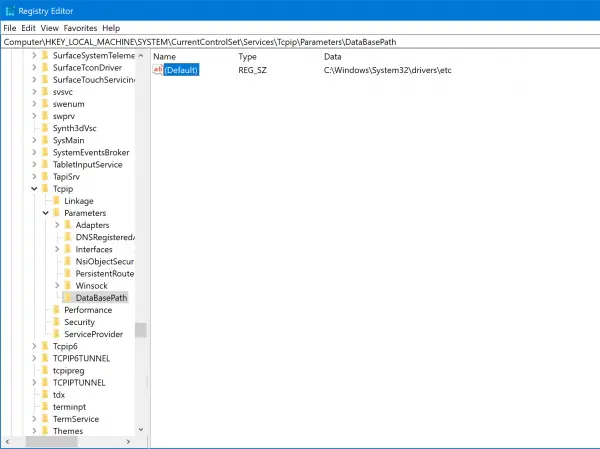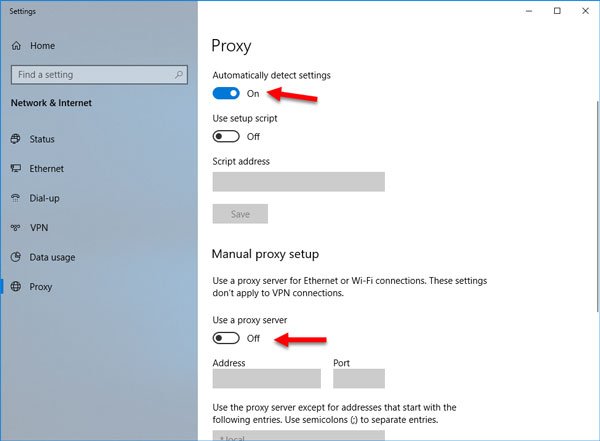If you see an error message ERR ICAN NAME COLLISION when browsing the web using Google Chrome browser on your Windows 11/10 PC, then here are a few things you could try to resolve the problem. This issue is caused due to an error in a private namespace or a random redirection to an incorrect proxy server.
The site can’t be reached, This site on the company, organization or school intranet has the same URL as an external website. Try contacting your system administrator. ERR ICAN NAME COLLISION.

Fix ERR_ICANN_NAME_COLLISION error on Chrome
The following methods should help you in fixing the ERR_ICAN_NAME_COLLISION error for Google Chrome on Windows 11/10:
- Use the Registry Editor.
- Check the integrity of the Hosts file.
- Check Proxy.
- Run a Malware Scan.
- Remove conflicting Browser Extensions.
- Flush the DNS.
1] Use the Registry Editor
From the Run utility, type in regedit and hit Enter. Once Registry Editor opens, navigate to the following key-
HKEY_LOCAL_MACHINE\SYSTEM\CurrentControlSet\Services\Tcpip\Parameters\DataBasePath

Now, for the default key, double-click on it and make sure that its Value data is set to be as:
C:\Windows\System32\drivers\etc
Reboot your computer for the changes to take effect.
2] Check the integrity of the Hosts file
Navigate to the following path inside of the File Explorer: C:\Windows\System32\drivers\etc
You will find a file named Hosts. Right-click on it and open it with Notepad.
Make sure that you write the block URLs on your computer in the list and save the file.
Sometimes, even when you are logged on with administrative credentials, you may receive an error message. In this case, type Notepad in Start search and right-click on the Notepad result. Select Run as administrator. Open the Hosts file, make the necessary changes, and then click Save. Or you may need to manually reset Hosts file back to default.
3] Check Proxy

Open Windows Settings by pressing Win + I button and go to Network & Internet > Proxy.
On your right-hand side, make sure the Automatically detect settings is enabled and Use a proxy server option is disabled under Manual proxy setup.
Now check if you can open a website or not.
4] Run a Malware Scan
Scan your whole system for malware or adware. Use any antivirus software to scan your computer. You may want to also use AdwCleaner. This useful freeware lets you carry out the following tasks with the click of your button:
5] Remove conflicting Browser Extensions
There are high chances that the extensions and toolbars installed on your browser might be conflicting with the loading of your website. So, to fix that, you need to remove or disable these extensions and toolbars. Maybe you could start Chrome in Safe Mode and then try to identify the offending extension.
6] Flush the DNS
From the WinX menu, run the Windows Command Prompt as an Administrator.
Enter the following three commands to flush the DNS cache:
ipconfig/release ipconfig/renew ipconfig/flushdns
Once done, just exit the Command Prompt and check if that fixes your issue.
The blocked websites must be accessible by now.
Leave a Reply